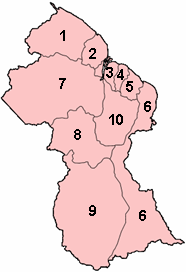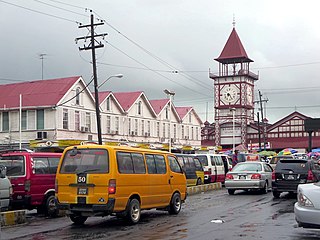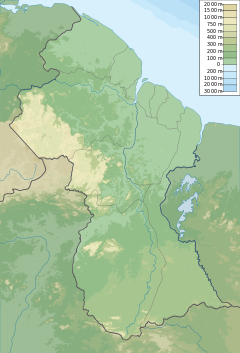
The politics of Guyana takes place in a framework of a representative democratic assembly-independent republic, whereby the President of Guyana is the head of government and of a multi-party system. Executive power is exercised by the President, advised by a cabinet. Legislative power is vested in both the President and the National Assembly of Guyana. The judiciary is independent of the executive and the legislature.

Guyana is divided into 10 regions:

The Berbice River, located in eastern Guyana, is one of the country's major rivers. It rises in the highlands of the Rupununi region and flows northward for 595 kilometres (370 mi) through dense forests to the coastal plain. The river's tidal limit is between 160 and 320 km (99–199 mi) from the sea.

Mahaica-Berbice is a region of Guyana, bordering the Atlantic Ocean to the north, the region of East Berbice-Corentyne to the east, the region of Upper Demerara-Berbice to the south and the region of Demerara-Mahaica to the west.

Demerara-Mahaica is a region of Guyana, bordering the Atlantic Ocean to the north, the region of Mahaica-Berbice to the east, the region of Upper Demerara-Berbice to the south and the region of Essequibo Islands-West Demerara to the west.
Rosignol is a village on the west bank of the Berbice River in Mahaica-Berbice, Guyana.
The Torani Canal in northeastern Guyana serves to move water from the Berbice River into the Canje River. It was to serve as irrigation for the sugar industry, and subsequently the rice industry.
The Abary River is a small river in northern Guyana that drains into the Atlantic Ocean.
The Mahaicony River is a small river in northern Guyana that drains into the Atlantic Ocean. Mahaicony village is found at the mouth of the river.
The Railways of Guyana comprised two public railways, the Demerara-Berbice Railway and the Demerara-Essequibo Railway. There are also several industrial railways mainly for the bauxite industry. The Demerara-Berbice Railway is the oldest in South America. None of the railways are in operation in the 21st century.
Esau and Jacob is a village in the Mahaica-Berbice Region of Guyana. One of the oldest villages on the Mahaicony River, Esau and Jacob was named by Dutch settlers after the pair of twins in the Bible.

Mahaicony is a community that is made up of several villages in East Coast Demerara, Mahaica-Berbice, Guyana. Mahaicony's physical boundaries on the coast is from De Hoop village in the west to Calcutta village in the east.
Belladrum is a small community in the Mahaica-Berbice Region of Guyana, on the Atlantic coast, about 15 kilometres (9 mi) east of Mahaicony.
Governor Light is a small community in the Mahaica-Berbice Region of Guyana. It stands on the coastal plain, at just one metre above sea-level, along the Mahaicony River, approximately 14 kilometres upstream from its mouth. Governor Light is named after Henry Light, the 3rd Governor of British Guiana.
St. Cuthbert's Mission is an Amerindian village on the Mahaica River in the Demerara-Mahaica region of Guyana. It comprises approximately 200 households. St. Cuthbert's is regarded by many people in Guyana as the "cultural capital" for Amerindians.
The East Demerara Water Conservancy (EDWC) is one of Guyana's major water storage and flood control facilities. Over 500,000 residents inhabit the basin that lies below and between the sea wall and the EDWC Dam in a 48 km band from Georgetown to Mahaica. Located in Demerara-Mahaica, the EDWC serves to irrigate thousands of hectares of rice and other crops within this area by storing rain water for dry periods and it also provides one of the primary source of drinking water for the capital city of Georgetown.
Mahaica is a village located in region 4 of Demerara-Mahaica in Guyana. Mahaica is often used as a subregion for the adjoining villages near the Mahaica River like Hand-en-Veldt, Good Hope, Chelsey Park, and Jonestown, which is often referred to as Mahaica or its old Dutch plantation name Voorzigtigheid.
Paradise is a village located in the Demerara-Mahaica region of Guyana, and used to be its regional capital, however the administrative building burnt down in 2006, and the regional capital moved to Triumph.
Fort Wellington is a village located in the Mahaica-Berbice region of Guyana, serving as its regional capital.
The 2005 Georgetown flood was a major flood in and around Georgetown, the capital of Guyana. It started during heavy rains in 2004, and came to a head in January, when sustained heavy rains and high tides over-topped the deteriorating water conservancy. Approximately 290,000 people were affected and the economic impact was estimated to be about US$465 million, or 59% of Guyana's GDP.





